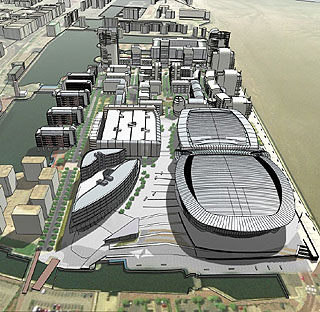
DJC.COM
October 6, 2005
After Katrina, the chance to build a better city
EDAW

Sterrett
|
"The pictures of the aftermath of the hurricane involving bodies and looting in New Orleans have parallels to the genesis of the urban regeneration program in the United Kingdom. As you may be aware, the pictures of the riots in Liverpool and other urban areas so shocked the conscience of the U.K. that there was a gradual change in policy emphasis with an increasing focus by central and local government in concentrating resources to address urban problems and urban deprivation. Furthermore, over time it was recognized that physical solutions on there own were an insufficient response to the problems and that the regeneration programs needed to include interlinked economic, social and community programs. Today we have a very active urban regeneration market with significant involvement by a plethora of public agencies and private developers."
In these weeks following Hurricane Katrina, we have heard news reporters again and again focus on racial issues in the government's slow response to our citizens in need. But is it really a racial issue? Or is it that our society has yet to grapple with the concept that we need to rebuild our cities in ways that support our citizens out of poverty?
If my British colleague is right, the disaster of Hurricane Katrina could become the saving grace of many cities and multitudes of the poor in this country over the next decade.
Could Hurricane Katrina then be the stimulus for new urban regeneration programs in the United States?

Image by EDAW
Since 1999, the United Kingdom has invested nearly $18 billion in what it calls "urban regeneration" projects, such as the redevelopment of Liverpool's Kings Dock, shown here.
|
A few months ago, I had the opportunity to visit London to learn about the U.K. programs for revitalizing cities that they call "urban regeneration." The visit was part of a knowledge exchange program between offices of EDAW, an international firm specializing in urban design and planning, landscape architecture and environmental services.
A few comparisons show how far we need to go to keep up with our neighbors across the pond:
1. In the United Kingdom, regeneration of cities and towns has been a policy objective of successive governments for more than 20 years. Just since 1999, the country has invested nearly $18 billion in regeneration activities. In the United States, there is no such national vision.
While some states (Florida, Washington and Oregon) have statewide growth management planning and a few others (Maryland) have smart growth policies, for the most part, regeneration of cities and towns is left to local cities. The result is that revitalization occurs only when local leaders have vision — and the financing to make it happen. Too often, the poor cities get poorer.
2. The United Kingdom's national directives have created redevelopment agencies, such as one called English Partnerships, that help the government support high-quality sustainable growth in England. English Partnerships works with local urban regeneration companies, which are independent companies formed by local authorities and regional development agencies.
In the United States, few states help and not all states even allow cities to have redevelopment authority. For those that do, the requirements to demonstrate blight can impede action. Protections established in the United States after the redevelopment abuses of the 1960s have left many cities with few, if any, tools at their disposal.
3. In the United Kingdom, social equity is one of the driving factors in regeneration. "Urban design draws together the many strands of place-making — environmental responsibility, social equity and economic vitality," according to the Urban Design Compendium issued by English Partnerships.
As an outgrowth of social equity, local councils and regeneration agencies define density standards, the mix of uses for a given site and even design standards. The U.S. system is driven by the private sector development market. With some exceptions, the local jurisdiction can set the vision and define the plan, but the final results are driven by developers. Social equity, too often, gets lost in the drive to profits.
Prior to the national focus on Hurricane Katrina and the many ideas put forth for the city's recovery, it has been evident that the United States is moving rapidly toward a different form of development. You can call it new urbanism or urban regeneration or some other name — but it is a major change. The proliferation of new terminology is, in itself, an indicator of the wave of change: smart growth, growth management, new urbanism, transit-oriented development, green communities, conservation development and LEED ND are all part of the wave of change.
All of these terms represent new ideas on urban form and how to create places that are true communities supporting the well-being of all citizens. Planners, designers and developers are poised to make major changes in our cities and towns, but perhaps we can also make major changes in the lives of the poor.
What does all this mean for us in Washington state? There are some obvious — and not so obvious — parallels we can draw and actions we can take:
Action: We can vote to maintain this tax so that government can take care of this kind of major infrastructure project. That's what government does best.
Action: We can participate in upcoming events about the waterfront and lobby the city to fund a full planning and urban design study to make sure that the tax dollars spent there provide for social equity as well as environmental benefits and quality design. That's just what our British counterparts have done in their urban regeneration programs.
Action: We can vote "no" on measures that undermine local government's ability to plan the kinds of communities we want to live in.
Remarkably, the speech by President Bush outlined a plan for recovery of New Orleans that has home-ownership programs for the poor, enterprise zones for new businesses and a host of publicly supported new buildings.
At this point, we can only hope that this broad-based program of support for New Orleans becomes a widespread program of regeneration for many of our cities and towns. At the same time, we can take action locally to make sure that Seattle and our state invests in our basic infrastructure, manages growth and plans for the future.
Jill Sterrett, FAICP, is a principal at EDAW. She has more than 25 years of experience in urban planning and has been active with the American Planning Association in refining the Growth Management Act.
Other Stories:
- Giving downtown Enumclaw a sense of place
- 5 mega-trends for Puget Sound real estate
- Can Pioneer Square-Stadium District be energy self-sufficient?
- GMA's success depends on local actions
- Finding a home for young urban workers
- Victoria project's goal: 26 LEED platinum buildings
- Seattle checks into the hotel-condo market
- Everett charts a new waterfront neighborhood
- How to build a town from scratch
Copyright ©2009 Seattle Daily Journal and DJC.COM.
Comments? Questions? Contact us.